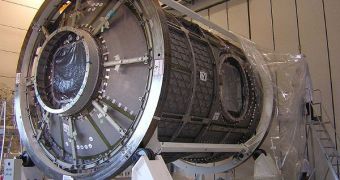The space shuttle Endeavor is scheduled to lift off for the International Space Station (ISS) on Sunday, February 7. The date was set a long time ago, and the American space agency has build a number of its plans for this year around it. However, standard pre-flight check-ups have discovered a number of serious glitches, which mission managers don't know if they'll be able to fix in time. At this point, engineers at the Kennedy Space Center (KSC), in Cape Canaveral, Florida, are working around the clock to fix the identified problems, but it's still unclear the deadline will be met, Space reports.
The most important payload Endeavor carries during the STS-130 mission is the Node 3 module, which is also known as Tranquility. This is the last great addition to the ISS before the US shuttle fleet is scheduled to retire. The structure is cooled by four ammonia hoses, two of which have been found defective during standard check-ups. What the KSC team is trying to do is essentially build two replacements from scratch. This may seem like an easy task at first, but there are very strict specifications that need to be met, so the experts have their work cut out for them.
“Folks are working really hard to get the hoses checked out, completed, certified [and] tested. We are still working toward the February 7 launch date,” NASA Expedition 22 Mission Manager Pete Hasbrook says. There are a number of factors that may be contributing to the malfunctions. While Node 3 was initially meant to be attached to the Earth-facing berth of the Unity connecting module on the ISS, engineers have recently changed that target location. Tranquility is now scheduled to be delivered to Unity's port (left ) side.
In order to make this possible, engineers had to use long ammonia coolant hoses. These devices are routed on the exterior hull of the ISS, and need to be able to withstand pressures in excess of 3,000 psi. However, in the KSC testing phase, they gave way at just 1,500 psi. Hasbrook says that the exterior braided-metal sheath, which covers the flexible hose, started falling apart during testing. A contributing factor may be that the routing hoses are more than 14 feet (4.2 meters) long. “We haven't used anything that long before. So that may be a contributing factor,” ISS Flight Director David Korth adds in a news briefing. It remains to be seen whether Endeavor will be able to stick to its schedule. Keep an eye on this space for more details.

 14 DAY TRIAL //
14 DAY TRIAL //